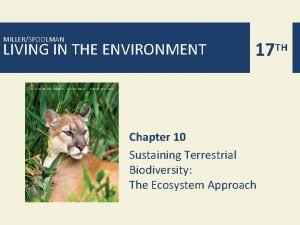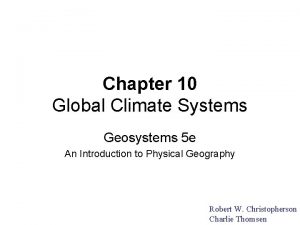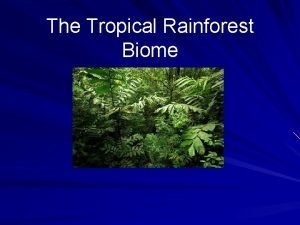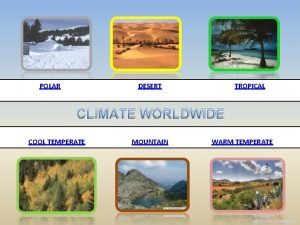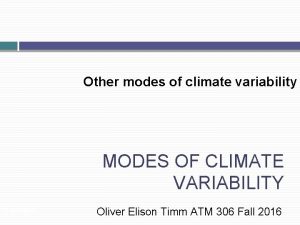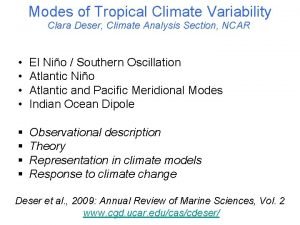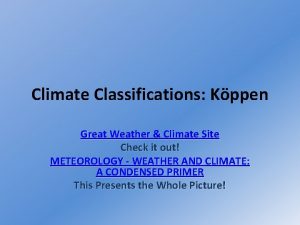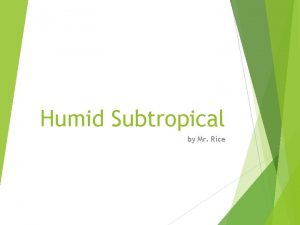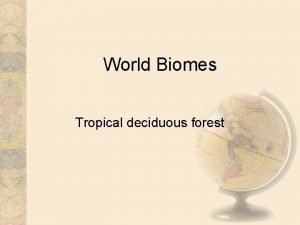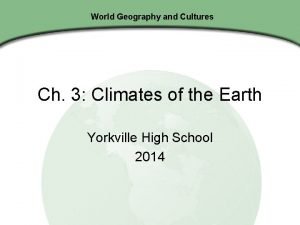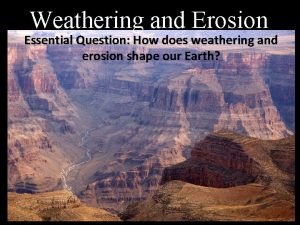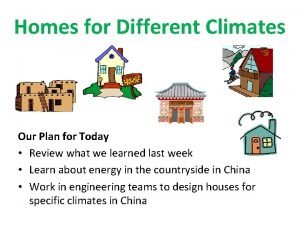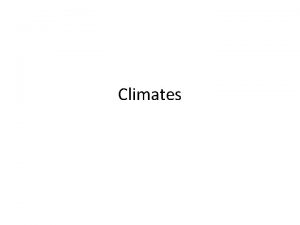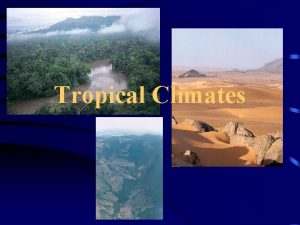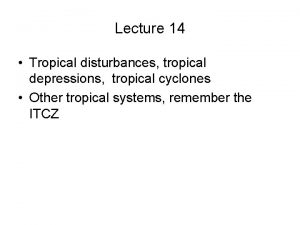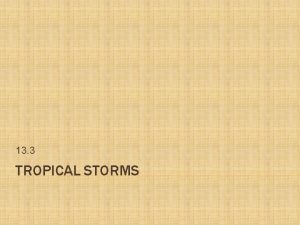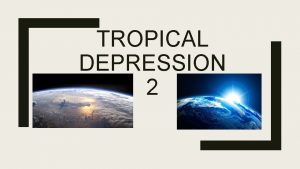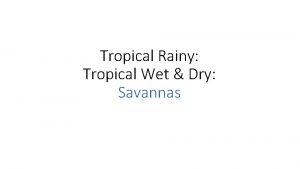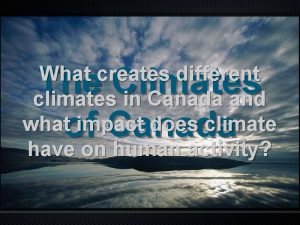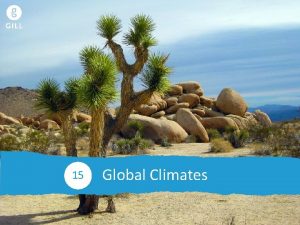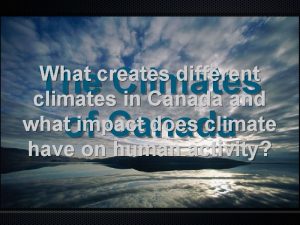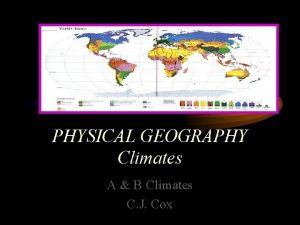Climate name Climate Description Tropical These climates are
















![Hot Deserts – Homework on the sheet By NASA/Goddard Space Flight Center [Public domain], Hot Deserts – Homework on the sheet By NASA/Goddard Space Flight Center [Public domain],](https://slidetodoc.com/presentation_image_h2/68d62feba6bb35d398381136e1890a0c/image-17.jpg)


- Slides: 19

Climate name Climate Description Tropical These climates are home to the world's rainforests, where rainfall and humidity are high. Temperatures are generally 25 -35 °C and vary little through the year. Dry The arid regions are linked to the High pressure, cloud free belts at the edges of the Hadley cells. Cold ocean currents can contribute to reduced availability of rainfall. The temperature range in these areas can be large, regularly exceeding 45 °C by day in summer and often falling to below freezing overnight in winter. Mediterranean These climates vary seasonally and have hot, dry summers and cooler, wetter winters. Continental Far from the effect of the oceans, these climates are characteristic of the interior of large land masses of middle latitudes; the main climate features are large annual and diurnal ranges of air temperature, with low rainfall a further characteristic feature. Polar Linked to the Polar Cell, these climates can be subdivided into Tundra and ice cap/frost depending on whether the mean temperature of the warmest month is above or below 0°C. The Arctic climate is moderated by the relatively warm Atlantic Ocean. In the Antarctic, the distance from the ocean and a source of water vapour can mean that it is truly too cold to snow. Temperate These climate zones lie between the tropics and the polar circles in the westerlies of the Ferrell cell. The changes in these regions between summer and winter are generally subtle (warm or cool), rather than extreme, (hot or freezing cold) and all of these regions have four distinct seasons. These climates can have very highly variable weather. One day it may be sunny, the next it may be raining. These climates can have a maritime influence. Photograph? Connect your learning 1. Identify 2 climate types that could classify as deserts 2. Name 3 deserts on the map

Hot Deserts

Hot Deserts Objectives Outcomes • To be able to describe the characteristics and location of a hot desert. • To understand WHY hot deserts are hot and dry. • To be able to draw and interpret climate graph. s • To understand animal and plant adaptations to the hot desert climate. • Descriptions of desert photographs and a map showing the location of hot deserts • A sequenced flow chart on why hot deserts are dry. • Completed climate graph with description. • Annotated camel and cactus pictures, plus your own INVENTED animal for a hot desert.

Hot Deserts 1. Copy the following information: • A desert is an area that receives less than 250 mm of rainfall per year. • Day to night temperatures can fluctuate dramatically from very hot in the day to much cooler at night due to the lack of cloud cover • Dryness and aridity are the main factors controlling life in the desert. 2. Describe the images below – use as many adjectives as possible Rub' al Khali or Empty Quarter is the largest sand desert on earth. By Nepenthes (Own work) [CC BY-SA 3. 0 (http: //creativecommons. org/licenses/bysa/3. 0) or GFDL (http: //www. gnu. org/copyleft/fdl. html)], via Wikimedia Commons Rocky Desert – Reg de L’Adrar by Ji-Elle [CC BY-SA 3. 0]

Hot Deserts - LOCATION ACTIVITY - Describe where we find hot deserts. What do they have in common? – write a bullet pointed list. Hot deserts can generally be found… The Latitudes of hot deserts include… A major hot desert is…found in… The climate zone it is in is known as…. Outline Sketch map of the World’s Climatic zones 80°N ARCTIC CIRCLE 66. 5°N 60°N Gobi 40°N TROPIC OF CANCER 23. 5°N ian Timbuktu ab Ar Sahara EQUATOR 0° Tropical Mediterranean Dry Atacama Kalahari Temperate Great Victoria TROPIC OF CAPRICORN 23. 5°S 40°S Mountainous Continental Polar Patagonian 60°S ANTARCTIC CIRCLE 66. 5°S

Reasons for the location of hot deserts

Model of Atmospheric circulation with surface winds added North Pole (90°N) HIGH PRESSURE 60°N Po lar Use the diagram to organise the slips to explain WHY hot deserts are found where they are. Ce Fer LOW PRESSURE ll l Ce rel A. More water vapour is evaporated into the air than condense ll PREVAILING WESTERLIES 30°N HIGH PRESSURE Hadley TROPICAL EASTERLIES Cell EQUATOR 0° LOW PRESSURE TROPICAL EASTERLIES 30°S HIGH PRESSURE PREVAILING WESTERLIES LOW PRESSURE 60°S © Rob Gamesby http: //www. coolgeography. co. uk HIGH PRESSURE South Pole (90°S) B. So cloud formation is limited C. The air pressure rises and air warms as it sinks D. So these areas are very dry E. Between the Hadley and Ferrell Cells air is sinking.

Model of Atmospheric circulation with surface winds added North Pole (90°N) HIGH PRESSURE 60°N Po lar E. Between the Hadley and Ferrell Cells air is sinking. Ce rel Fer LOW PRESSURE ll ll 30°N HIGH PRESSURE Hadley TROPICAL EASTERLIES Cell EQUATOR 0° LOW PRESSURE TROPICAL EASTERLIES 30°S C. The air pressure rises and air warms as it sinks l Ce PREVAILING WESTERLIES HIGH PRESSURE PREVAILING WESTERLIES LOW PRESSURE 60°S HIGH PRESSURE South Pole (90°S) A. More water vapour is evaporated into the air than condense B. So cloud formation is limited D. So these areas are very dry

This is a village camp close to Timbuktu – what sort of climate do you think it has? https: //commons. wikimedia. org/wiki/File: Sahara_Desert_Tribal_Camp. jpg

Hot Desert Climate 40 80 33 34 30 30 32 30 31 30 27 25 20 70 24 60 25 50 22 21 40 30 10 20 5 10 0 0 January February March April May June July August September October November December 15 Precipitation / Rainfall (mm) Avg. Temperature (°C) Precipitation (mm) 35 Temperature (°C) Describe VERBALLY the climate for Timbuktu. Mention (give data and month name): • Maximum temperature • Minimum temperature • Average temperature and variation in temperatures (maxmin) • Maximum precipitation • Minimum precipitation • Total precipitation and variation in precipitation (max-min) Can you talk uninterrupted for 60 seconds? A climate graph for Timbuktu, Mali

Desert Vegetation adaptations 1. Read the text on camel and cacti adaptations 2. Annotate your pictures of the camel and cactus to show they have adapted to the desert environment By Imartin 6 (Own work) [CC BY 3. 0 (http: //creativecommons. org/licenses/by/3. 0)], via Wikimedia Commons

Making plants and animals – Deserts Look at the task sheet You have to create both a plant and an animal using the characteristics on the tables opposite. Both of these need to fit the climate and environment of a hot desert. 1. Your plant and animal can have 6 characteristics each. 2. List the characteristics that would be useful 3. Pick six from the lists. 4. Creatively draw both your animal and plant to display its adaptations to the climate of hot deserts. 5. Name your plant or animal. 6. Around your drawing you need to JUSTIFY the characteristics, linking to the original data sheet. This should be written in full and link to the actual climate. Drought resistant Wide root system Floats Waxy, pointed leaves Broadleaves Thick bark Heavy-weighted seeds Loves water Deep root system Survives under water Deciduous Needle leaves Rough bark Fragments take root Stores water Lives on other plants Dies back seasonally Evergreen Stunted Wind blown seeds Seeds with Velcro like hooks Like strong sun Runners put down Climber roots Likes shade Tall Salt tolerant Bears fruit (nuts and Flowering Pollinating berries) Eats insects Branching Sticks to rocks Lifecycle within days Colourful Drab Pleasant smell Awful smell Changes colour Buttress roots (large Flexible branches Sticky surfaces roots to support huge trees) MAKE UP YOUR OWN CHARACTERISTICS AS WELL!

Review – Mini Test…. 1. How do we define a desert using precipitation? 2. What happens to daily temperatures in the desert? 3. What is the typical air pressure in our desert areas? 4. Why are deserts dry? 5. What does the line represent on a climate graph? 6. Name 2 ways a camel is adapted to survive in the desert 7. Name 2 ways a cactus is adapted to survive in the desert

Review Rearrange these letters to make the names of deserts 1. 2. 3. 4. 5. 6. 7. tancarctia haasar banaria bigo harkalai tager rictovia tagopanian 1. 2. 3. 4. 5. 6. 7. Antarctica (Antarctica) Sahara (North Africa) Arabian Desert (Western Asia) Gobi Desert (Central Asia) Kalahari Desert (Southern Africa) Great Victoria Desert (Australia) Patagonian Desert (South America) Extension: 1. Name the continent each desert is found in. 2. What order do you think they are in?

Is someone in Africa seeing the same sky as someone in Antarctica? Thunk Questi on

Hot deserts & climate change 1850 1900 1950 As the climate changes, the Hadley cell is expected to widen, moving the world’s dry climate zones. How could local communities reduce the impacts of their climate becoming drier? 2000 2018
![Hot Deserts Homework on the sheet By NASAGoddard Space Flight Center Public domain Hot Deserts – Homework on the sheet By NASA/Goddard Space Flight Center [Public domain],](https://slidetodoc.com/presentation_image_h2/68d62feba6bb35d398381136e1890a0c/image-17.jpg)
Hot Deserts – Homework on the sheet By NASA/Goddard Space Flight Center [Public domain], via Wikimedia Commons

Deserts, semi deserts and desertification By USDA employee https: //www. nrcs. usda. gov/wps/portal/nrcs/detail/national/n edc/training/soil/? cid=nrcs 142 p 2_054003, Public Domain, https: //commons. wikimedia. org/w/index. php? curid=1349739 • Deserts are any location on the planet that receive less than 250 mm of precipitation a year. • Often on the edges or margins of these deserts areas that are just above that 250 mm figure – these are known as semi deserts • Many people are worried that these semi deserts could be become deserts in a process of desertification • The United Nations' official definition says desertification is land degradation in typically dry areas resulting from various factors, including climatic variations and human activities.

By USDA employee https: //www. nrcs. usda. gov/wps/portal/nrcs/detail/national/nedc/training/soil/? cid=nrcs 142 p 2_054003, Public Domain, https: //commons. wikimedia. org/w/index. php? curid=1349739
 Antigentest åre
Antigentest åre Brainpop ocean currents
Brainpop ocean currents Unfenced grasslands in tropical and temperate climates
Unfenced grasslands in tropical and temperate climates Explain how köppen’s climate system classified climates.
Explain how köppen’s climate system classified climates. Tropical rainforest biome average temperature
Tropical rainforest biome average temperature Desert climate
Desert climate Cfa humid subtropical
Cfa humid subtropical Tropical climate
Tropical climate 1 standard deviation
1 standard deviation Kppen
Kppen Tropical wet climate characteristics
Tropical wet climate characteristics Crash course kids weather
Crash course kids weather Humid tropical climate characteristics
Humid tropical climate characteristics Tropical deciduous forest location
Tropical deciduous forest location World geography chapter 3 climates of the earth
World geography chapter 3 climates of the earth Climates of earth lesson 1 answer key
Climates of earth lesson 1 answer key Different climates around the world
Different climates around the world Weathering
Weathering Houses in different climates
Houses in different climates Types of communication climate
Types of communication climate


